In the blog on April 4th, we discussed the purpose and structure of a curriculum. Our journey taking a look at all the learning areas of early childhood education goes forward! This week we focus on the fourth area, Exploring and interacting with my environment.
.png)
This learning area is important for children's development as it gives children various tools for thinking and operating in our environment. The learning area "Exploring and interacting in my environment" includes also specific learning objectives that are listed below. It makes it easier for educators to plan activities when the specific learning objectives are listed clearly.
Exploring and interacting with my environment
This learning area focuses on mathematical thinking, technology, nature, and the environment. Children are encouraged to analyze, think, and apply their knowledge. These are important skills in today's world and those skills are enhanced through playful exploration and experimentation. Children are encouraged to be curious, ask questions, look for answers, and make conclusions together in a team. Of course, children do this also spontaneously and it is part of their development, sometimes it seems that children's questions are never-ending and super tricky!
.png)
.png)


